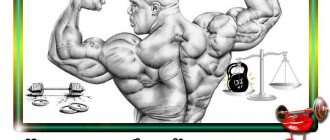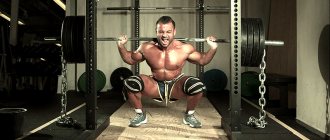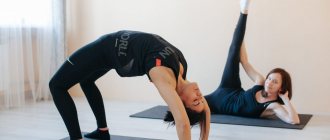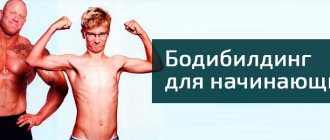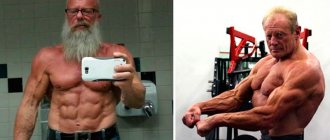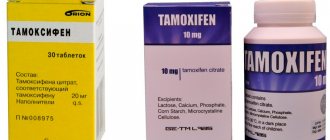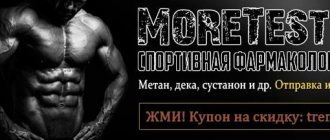Stuart McRobert, a provincial bodybuilding enthusiast, has always advocated healthy sports, without the use of steroids, as well as other artificial drugs. His merit is that he was able to develop his own special training method, thanks to which he made a revolution in the world of bodybuilding. This technique is the basis of all healthy amateur bodybuilding. Unfortunately, without muscle tissue growth activators it is almost impossible to achieve serious results, but it is very possible to form a beautiful body.
What are the stages of the program for beginners?
A beginner trains as often as possible, using weights below the maximum. They strive to improve their fitness, flexibility, sleep and diet.
The athlete adds weight to the bar until the workout becomes really hard for him. Squats and deadlifts are usually in the range of 60 – 80 kg. Time to change the program, right? Wrong. Instead, he gets the advice to “eat more.” And this literally always makes it possible to add another 10 kilograms to the squats and deadlifts. 10 kg is not a very big step, it's just a pole
What really matters is the lesson, which is how increasing your diet affects progress. You can't learn this just by reading.
You need to experience this for yourself. You must learn to recognize the moment when you can and should increase the amount of food.
Take note of this and share with those who are afraid of overtraining by squatting and deadlifting 3 times a week: most of those on this forum who did the beginner program got to 70 - 80 kg in these exercises before needing to change the program . Most of them have surpassed this level
At approximately this level, two amendments are made: 1) Deadlifts are done through training, on other days shrugs are done instead. Shrugs are performed after pull-ups/latt rows, which allows you to make progress in this exercise. 2) A warm-up set of 60 x 8-12 is added to the squats.
When an athlete reaches 85 kg in deadlifts and squats, one of the working approaches becomes a warm-up. Now your squats might look something like this: 60x10, 83x10, 88x12, 88x12
On deadlift days, the athlete typically does not do working sets of squats. Then it will look something like this:
- Squats 60x10, 83x10
- Standing press
- Deadlift 70x8, 90x10, 90x10
If the athlete reaches 100 kg, the procedure is repeated. New warm-up approach, and the number of workers is reduced to one. It may also be necessary at this stage to reduce your training frequency or separate your squats and deadlifts. This is already individual.
What? Why wasn't the training frequency reduced sooner? Because when a beginner asked about this, he was told “eat more.” And usually he could continue to progress by increasing his diet. However, sometimes you really need to reduce the frequency. This is also individual. Beginners are usually not very good at recognizing when they are truly at their limit. Remember that the first program aims to prepare the athlete for subsequent success. One of the important factors for success is knowing how your body reacts. You can't read about it. You need to experience this for yourself.
McRobert's training program
Option #1
Workout #1
- Romanian deadlift – 1 set of 15 reps and 1 set of 10
- Military press – 1 set of 10 reps and 1 set of 6
- Wide grip pull-ups – 1 set of 12 reps and 1 set of 8
- Dips – 1 set of 10 reps and 1 set of 6
- Calf raises – 2 sets of 20 reps
Workout #2
- Barbell squats – 1 set of 15 reps and 1 set of 10
- Bench press – 1 set of 12 reps and 1 set of 8
- Shrugs – 1 set of 15 reps and 1 set of 10
- Seated dumbbell press – 1 set of 8 reps
- Bent-over barbell row – 1 set of 10 reps and 1 set of 6
- Biceps curls – 1 set of 10 reps and 1 set of 6
Working approaches are performed until “failure”, while you can use 1-2 warm-up approaches to prepare the central nervous system for issuing stronger nerve impulses.
Dangers
Even though you train different muscles on different days, you shouldn't skimp on rest days. Fatigue accumulates gradually, and you won’t even notice how frequent training will lead you into the quagmire of overtraining. In short, rest more, especially at the beginning of the training.
Many amateurs make this mistake. They train according to a similar scheme with a break of just one day. They get about 4 workouts a week, but this actually means loading the entire muscle twice a week. I repeat, such a “feat” is completely beyond the power of an ordinary amateur!
In this regard, I will once again remind you of the main rule. It's not a matter of how often you apply a training stimulus to a muscle, but how effective it is.
Although we are talking about different exercises, you need to take a long break between workouts, certainly more than one day. It happens that an amateur does not even have 3-4 days of rest.
If you see that the weights are not growing at all and, in addition, a wave of rapid energy surge does not roll over you in the gym, then you need to train less than two days a week. Again, there is nothing wrong with all this. Who cares how many times you go to the gym, as long as your muscles grow!
However, even with a long rest between workouts, you may encounter serious difficulties of a different kind. Look, on the first day you do squats and bench presses, and on the second day you do deadlifts and standing presses. All these exercises equally load the lower back. It may turn out that the total weekly load for the lower back will be excessive. The same can happen with the shoulder girdle. The bench press and standing press equally overload the muscles of the shoulder girdle, so here too the total weekly load on the shoulders may be too great. In this case, I recommend setting the rest interval between workouts exactly one week.” However, another way out is possible: you need to “assemble” the complexes in a new way. In the first complex, include squats and deadlifts as the main exercises, and in the second - bench press, chest press and pull-downs. In this case, the exercises will no longer “cross” and you will be able to increase the frequency of training.
Here someone will exclaim: “How difficult! Head is spinning!" Well, it’s really not easy. But only at first. Over time, you will “catch” in yourself that same feeling of high mental and physical tone that accompanies a well-established training program. And you will know exactly how much training load it corresponds to. Taking it as a guide when assessing or drawing up a training plan, you can easily rearrange exercises, throw them out or add them in order to precisely “tailor” the complex to your natural resources.
Well, until you understand this science, I suggest you experiment with program 2. Here's how it's done. Do everything according to the pattern at first, giving yourself enough rest between workouts. The weights will grow well, but when progress slows down, “reorganize” the complexes; as shown above. The weight will start to come back on - you will be able to slowly progress over many weeks. When this resource is exhausted, increase the rest interval between workouts. For example, you can start training like this; Monday – Thursday – Wednesday (next week) – Monday (next week). It may turn out that with such rare training, your progress, on the contrary, will slow down. Then return to the very first scheme of two workouts per week.
Complex 3 Three-time program
The three-day training program itself does not contain anything new; the same basic and auxiliary exercises. However, there is one fundamental “trick” here - auxiliary exercises are combined into a complex and performed, so to speak, in one small manner as part of a one-time “intermediate” training.
Basically, most amateurs are not able to train three times a week and still make progress. However, if in the middle of the week you perform only auxiliary exercises, and there are no “crossing” exercises in the other two basic complexes, then the threat of overtraining will be reduced to a safe minimum. But performing basic complexes three times a week for amateurs who do not use pharmacology is tantamount to suicide.
Here is an example of a training program designed for three workouts per week.
First stage of the Stuart McRobert program
The main task of the athlete at the first stage of the “Hands of the Titan” training by Stuart McRobert is to increase strength indicators. You should visit the gym twice during the week. On the first day of training, 3 exercises are performed:
- Bench press;
- Squats;
- Pull down.
The second day you need to work in four exercises:
- Deadlift;
- Shrugs;
- Bench press, narrow grip;
- Pull-ups.
The volume of training should be limited and all attention should be paid to basic exercises.
Athletes must remember that they can make significant progress. The training program involves a 5x5 scheme, which means five sets of five repetitions each. In each movement, the first set should be a warm-up and performed with a light weight. After this, the working weight should be increased in each approach. You should also change your nutrition program. At the first stage, give up all sports supplements, leaving only vitamin and mineral complexes in your diet. Meals during the day should be divided into 4 to 5 times. The diet should consist only of natural products.
Many athletes make a serious mistake by relying heavily on various supplements. You must understand that the body must obtain most of its nutrients from regular foods. Supplements are just an addition to your diet. It should be noted that as muscle mass increases, the body's need for nutrients will increase and you will have to eat more.
Pros and cons: balancing
There are many interesting ideas to be found in both Stuart McRobert's books and articles. Of course, the strength of his books is the attempt to psychologically prepare beginners for weight training: “You will have failures. You will have injuries. You will be wrong. You will have periods of depression and despair. Family, study, work, everyday problems - all this will interfere with the training more than once or twice. However, the needle of your internal compass should always point in the same direction – towards the goal.” And one more thing: “Even with so-called “average abilities,” an amateur can achieve a lot. However, even in this case he will remain far from the image of the Olympia participants. Perhaps these words of mine will disappoint someone, but they will help maintain sobriety. There is nothing worse in bodybuilding than having unrealistic expectations. They give rise to disappointment, and then the desire to abandon the training forever.” Well said, I can’t help but agree with this!
It is very useful to replace the concept of “week,” which has become firmly entrenched in the consciousness of the vast majority of gym goers, with the concept of “minicycle,” the length of which does not necessarily have to be seven days. It is an undeniable recommendation to start training in the gym by learning the correct technique for performing movements. We also cannot but agree that basic exercises are better suited for gaining mass than isolating exercises. In some cases, training using only basic exercises in a shortened program will allow you to make progress. Even experienced athletes should sometimes resort to this technique - and it can help them overcome the stagnation that has arisen. These are, so to speak, the arguments “for”.
There are more arguments against. Firstly, the assertion that eighty-five percent of gym goers are only suitable for the method proposed by Stuart McRobert looks, to say the least, ridiculous. Of course, the initial set of exercises may be approximately the same for everyone, but only the initial one. And this initial complex should certainly not be built according to McRobert’s recommendations. Well, then the search begins for exactly what you want. There are many reasons for the lag in gaining muscle mass; not all problems can be solved only by changing training programs, especially since there cannot be one training program for everyone for all occasions.
Focus only on the “base”... The owner of many records in the bench press, Vladimir Kravtsov, does not focus only on bench press exercises, including in his training programs those that McRobert considers useless. And come on, it looks impressive, it’s not short of strength, and it’s not short of mass either.
McRobert’s call to continuously increase strength indicators also looks strange. “Consistently increase 5% in each exercise” cannot be done indefinitely. This is a utopia. Progress cannot be constantly increasing; it does not obey the rule of linear dependence. The indiscriminate denunciation of androgens and anabolic steroids from the pages of Stuart McRobert's books does not look very pleasant. It is especially unpleasant to hear this from a person who has very little understanding of pharmacology, and has never used anything that most bodybuilding admirers use. Interestingly, sports nutrition is also anathematized. Also indiscriminately.
And one last thing. “I myself started “swinging” at the age of 15. If I had chosen squats, deadlifts, bench presses, standing and seated presses, rows and rows, and consistently increased the weights in these “core” exercises for five years, I would have been able to almost fully realize my bodybuilding potential already by the age of 20. It would be much better if I didn’t know about the existence of other exercises at all.” Then there are dreams of how big and strong the author of the best-selling book “Think!” could have become, if... Alas, he didn’t - his dreams remained dreams. For some reason only known to him, Stuart McRobert was unable to realize his own potential; even at the best of times he looked completely unimpressive. Despite the fact that he followed his own – “extremely progressive” – methodology. Perhaps it's all about her?
CLIENT DOSSIER
Flynn began to carefully collect information:
— How much do you bench press?
“Five times 55 kg, but I rarely do this,” the guy answered. “I don’t want my arms to be blurred against the background of my chest and shoulders.”
- Clear. What about squats and deadlifts?
- I never do them at all. And then, exercises for the legs and back are very tiring. And I need to save strength for my biceps and triceps!
Then the conversation turned to food. Although nutrition is a strong word: the guy ate almost nothing except some ultra-modern dietary supplement from anabolic-metabolic optineurogranular amino activators.
“If you want to look like a champion, you need to eat like a champion,” the guy explained to Flynn.
“That’s true,” Flynn confirmed with the most serious look.
Chapter 18. The “Think” Method by Stuart Mac Robert: Towards a Great Bestseller
Once upon a time I picked up Stuart Mac Robert’s book “Brawn” and read it carefully. At that time, I had only been working as a gym instructor for three years, but I already had some formed views on the principles of training. I was pleased to read this book, but not because I discovered a lot of new things, but because I discovered that someone thinks the same way as me.
However, over time, I began to understand bodybuilding in more depth, read many other books besides the bestseller “Think,” including scientific books, and tested basic techniques on many volunteers.
After a few years, I had already learned to separate the wheat from the chaff and had a much better understanding of what works in books and what, on the contrary, is a fallacy.
Now I have created the “Biceps” method for beginners, and with all due respect to Stuart, as a pioneer, I claim that my method will allow beginners to pump up faster and more.
However, the fact remains: “Think” is a great book, one of the best techniques for bodybuilders and the first technique for them.
In this article, I propose to share my impressions of Stuart McRobert’s method. I express my pros and cons.
Disadvantages of Stuart McRobert's bestsellers and techniques
- McRobert's strength results, as a natural, are quite decent, but not outstanding (for example, bench press 120 kg).
- McRobert's visible results are unknown (That's suspicious! Does he look like a coach that followers should follow?).
- The popularity of the author’s technique is artificially inflated, since he was promoted by the magazine “Strength and Beauty” with a million copies, with the goal of selling as many copies as possible, and the technique is clearly commercial “for anyone and everyone who does not take steroids.”
- Some statements in McRobert’s books are erroneous, for example: “to grow arms, you need to squat,” “lateral raises are very dangerous,” “all competitive bodybuilders are genetic monsters and “pumped up” only through chemistry.”
- The statement that with “chemistry” anyone can achieve weight - you just sleep, and the muscles grow!
The benefits of Stuart McRobert's bestsellers and techniques
I consider the following statements by the author to be positive:
- Shortened training is very effective, especially for naturals.
- Compound exercises are the best way to gain mass and strength.
- Cyclic training makes it possible to grow more.
- Squats increase endogenous testosterone production.
- Increased strength is necessary for muscle growth.
- The rest between heavy sets should be long.
- An excess of aerobic exercise and, in general, work on relief destroy progress in increasing strength and mass.
- Nutrition, recovery and sleep are extremely important for muscle growth, and overtraining is the main bane of a bodybuilder.
- Strict vegetarianism and bodybuilding are incompatible.
Be that as it may, McRobert’s books have forever entered the world bodybuilding library, and every coach and seriously training athlete simply must read them carefully. I invite every visitor to the Biceps website to leave their feedback on my article on the book “Think” and on Stuart McRobert’s method in general.
Discuss Stuart McRobert’s “Think” technique and this article by Yuri Spasokukotsky on the forum
This is interesting: Muscle corset - core muscle training, effectiveness, practice and scientific research
NEW DIET
Under Flynn's leadership, the guy buried supplies of his super-supplement in the yard. I wonder if the grass will wither over this grave? - Flynn and I wondered. (As it turned out, it withered). Since then, the only supplement our young friend took was vitamins and minerals. And then one tablet a day. But in general, his diet consisted of natural, high-quality food: eggs, milk, cheese, meat, fish, pasta, bread, potatoes, vegetables and fruits. He ate hearty meals four to five times a day. As soon as I felt hungry, I immediately swallowed something solid. And he washed it down with one or two glasses of milk.
- So, does everyone have to eat like this? - I asked Flynn.
- No, only young and thin. But a man over thirty can limit himself to three meals a day: a good breakfast, a hearty lunch and dinner. The main thing is to eat high-quality, healthy foods. And get all your nutrients from them, not from supplements. As your training gets harder, you also need to eat more to provide your growing body with everything it needs.
Three months later, the guy added 13 kg in the bench press, 18 in the squats and 20 in the deadlift. In addition, he himself gained 4.5 kg - only due to muscles. Flynn told him that things were looking up and it was time to move on to the second phase of the program. But first, ten days of complete rest.
Constancy
Hobbyists should definitely adapt the available techniques to their genetics. At the same time, some have to make more significant changes to their usual patterns than others. Actually, it always takes time to experiment and make mistakes. However, some bodybuilders find what they need almost immediately, while others spend months and years searching, even if they are moving in the right direction and choosing reasonable methods. The variety of techniques is too great. Just as there is a great difference between people. It often happens that amateurs are fatally misled by the ineffective methods that bodybuilding literature is full of, and they find the right path only years later. And some people are unable to find a method that allows them to truly increase muscle mass and strength.
Even if everything goes well, progress in bodybuilding cannot be the same over time. Sometimes you will make rapid progress, and sometimes you will have to overcome periods of stagnation. Be persistent. Do not give up. The main thing is not to repeat mistakes. Keep a training diary and write down everything you achieve. You need these notes to determine how to proceed.
A huge success after many years is a lot of small successes from month to month. Little by little, brick by brick, this is how the building is built. Think about the huge skyscrapers built by people. They were built floor by floor. A person is “built” in the same way in bodybuilding. Let the girth of your biceps and calves increase by at least half a centimeter. Increase the weight little by little and you are sure to gain another half an inch, and then another. Someday your barbell will lift a hundred kilograms, and your muscles will double and triple in size. The main thing is regularity of training.
Mistakes, disappointments, injuries (not necessarily caused during training) and failed experiments are part of life. You can't escape them. But they strengthen us. There will be times when you will have to fight just to maintain what you have already achieved; then one can only dream of progress. And then everything will start to work out again, and you will quickly go uphill. No matter how difficult it is, don't give up. Only the persistent can achieve something in bodybuilding. Winning takes time—a lot of time. So, the main thing is regularity of training.
| &Menu | 1999-2020 ATHLETE.RU |
| | training | food | pharmacology | photo gallery | links | books | |
ATHLETE.RU 1999-2020
GENERAL SCHEME OF THE PROGRAM
Phase 1:12 weeks (the first four are introductory, 8 are difficult).
Phase 2:3 weeks
Rest 10 days
Phase 1: 6 weeks (2 weeks introductory, 4 heavy).
Phase 2: 3 weeks Rest 10 days, return to a balanced program.
In the last stage of any program, whether experienced or new, you are required to rest, sleep and eat more. The final stage is a new territory, and you need to master it fully armed. If you feel like you're overloaded, you can eliminate work on your abs, calves, and even grip.
Don’t forget: this is a program for experienced people, that is, those who have reached 40 cm in arm circumference, bench press 135 kg, squat 180 and deadlift 226 kg. If you haven't reached this level yet, work on the beginner program.
Philosophy[edit | edit code]
McRobert
focused on strength training for the so-called “
hard gainers
” - people with an “
ectomorph
” body type. He believes that most of the workouts published in the bodybuilding media are ineffective for the average person (without genetic advantages and/or steroid use) or are harmful.
He emphasizes strict, correct form in weight-bearing strength exercises to avoid injury, and his publications are exhaustively detailed about correct and incorrect form. Beginners should only use weights that allow them to maintain a strict form of movement. You need to train with a gradual increase in the volume of training to prevent injuries. McRobert
also recommends active training methods and trigger zone therapy between sets to minimize discomfort and injury. In his latest book, he also cites the benefits of yoga for improving muscle and overall body flexibility.
Publicationsedit | edit code
Publishing house " CS Publishing"
»
MacRobert
published 6 of his books:
- "Brown"
- "The Insider's Tell-All Handbook On Weight-Training Technique"
- "Beyond Brawn: The Insider's Encyclopedia on How to Build Muscle & Might"
- "New BRAWN Series, Book 1: How to build up to 50 pounds of muscle the natural way"
- "Build Muscle, Lose Fat, Look Great: Everything You Need to Know to Transform Your Body"
- "The Muscle and Might Training Tracker: The Week-by-Week Journal for Charting Training Success"
The author's works describe in detail how to perform the exercises, and analyze the most common mistakes. He especially emphasizes that when starting strength training, it is necessary to work only with the weight that will allow you to perform the exercises correctly. Stewart
recommends increasing weight gradually to avoid injury.
GENERAL VIEW OF THE PROGRAM
“When you finish the second phase,” Flynn continued, “you will take 10 days off.” After this, you will return to the first phase training and stay on it for 6 weeks. Start easy, don’t rush into battle for the first two weeks, lift heavy weights only in the last 4 weeks. Then repeat the second phase. After it - again 10 days of rest. And move on to a more balanced training program built around the squat, bench press and deadlift.
It looked like Flynn was wrapping up his lecture.
- If you really want to build big arms, go through this program once a year. And you don't need anything else. Just remember to constantly increase the weights. If you work with the same weight, your arms will become mothballed.
Supply system
Correct exercises are the key to success
In order to change your body, you need not only to exercise regularly, but also to eat right. You need to eat much more and more often, but you won’t be able to switch to such a diet right away. One of the main products is milk. You need to drink it regularly, it replenishes iron. Natural milk is much healthier; for those who do not digest lactose, you can try skim milk. This type of liquid food can be replaced with yoghurt or a cocktail made from egg whites.
It is necessary to reduce to a minimum the consumption of products containing preservatives and chemicals. You need to make up your diet from a variety of foods. It is not advisable to eat the same food all the time; giving up your daily diet for a while will improve your appetite. Porridges need to be alternated, and always use different products as a side dish.
You should avoid consuming fatty and cholesterol-containing foods. Stuart McRobert opposes a total ban on the consumption of such products. He believes that if a person is healthy and does not have bad habits, then such “harmful” foods in the diet are acceptable.
You need to realistically assess the load on the liver; the absence of steroids and a healthy lifestyle allows you not to adhere to a strict diet. Periodically you need to have your blood tested to monitor your cholesterol levels. This procedure will allow you to determine the benefits of the chosen diet.
Despite the protest against the classical nutrition system, the athlete still recommends counting calories, especially at the beginning of his sports journey. You need to consume the same amount of calories for several weeks. Afterwards, you need to find out your weight and decide what result the nutrition system brought. If you are not gaining weight, it is better to add 300 calories per day. On average, an athlete needs to consume about 4,000 calories. Once the desired result is achieved, the need for such nutrition will no longer exist.
You cannot sharply increase both physical activity and the number of calories. It is better to increase portions gradually, and increased nutrition should accompany only the most intense training cycle. During this period, the foundation of the athlete’s future figure is laid. Energy needs to be directed towards gaining muscle mass; if a fat layer appears, then it is necessary to reduce the calorie content of the diet.
Stuart McRobert defines appetite as an indicator of the effectiveness of both training and diet. If after strenuous physical activity you feel tired and there is no desire to eat, it means the body is not getting enough or the training was less intense. This type of fatigue is often observed in vegetarians; eggs and milk should be included in the diet.
It is recommended to drink a milkshake an hour before training; such food is easily digestible. It is unacceptable to starve the body; after exercise, an hour later, the use of the cocktail must be repeated.
Stuart McRobert
Stuart McRobert, a provincial bodybuilding enthusiast, has always advocated healthy sports, without the use of steroids, as well as other artificial drugs. His merit is that he was able to develop his own special training method, thanks to which he made a revolution in the world of bodybuilding. This technique is the basis of all healthy amateur bodybuilding. Unfortunately, without muscle tissue growth activators it is almost impossible to achieve serious results, but it is very possible to form a beautiful body.
Anthropometric and strength indicators
At the very top of his sports career, Stuart Mac Robert managed to increase his muscle mass by 25 kg, with a height of 175 cm and a weight of 95 kg. And this is solely thanks to his new technique, without the use of any stimulants. Its strength indicators are as follows:
- Lifting the barbell while lying down - 120 kg.
- Deadlift - 200 kg.
- Squat - 160 kg.
Training system
In his book Think!, Stewart described his training system in detail. This book became a bestseller and was published six times, thanks to which the athlete managed to become the founder of amateur bodybuilding. The training scheme is based on the fact that the anthropometric data of the novice athlete is taken into account, so it was possible to select the appropriate set of exercises individually.
According to the author, the age of the athlete plays a decisive role in achieving high results. As he claims, you can always count on significant success, but only until the age of 35.
To select an appropriate training program, it is important to take into account the physical characteristics of the athlete. The calculations are based on 3 main indicators: height - 175 cm, wrist size - 17.5 cm and weight - 76 kg.
For beginning athletes with such parameters, the author of the book recommends the following:
- Squats with a weight of 150 kg.
- Lying barbell lifts weighing 110 kg.
- Bench press - 65 kg.
- Deadlift - 180 kg.
These basic exercises are complemented by several approaches of the following nature:
- 10 approaches - squats with a weight of 120 kg.
- 10 sets - deadlift with a weight of 140 kg.
- 10 approaches - deadlift on straight legs with a weight of 110 kg.
- 6 approaches - bench press, weighing 100 kg.
- 6 approaches - overhead barbell press, weighing 50 kg.
- 8 approaches - biceps curls 40 kg.
- 8 approaches - bench press with a narrow grip, weighing 90 kg.
- 20 times - calf raises, with a weight of 20 kg.
All training must be carried out under normal operating conditions. If you reduce the speed, it will not bring any dividends. When an athlete prefers a slower pace, it is better to reduce the load by removing a little weight.
The individuality of the athlete also plays an important role. In order for muscle definition to appear, you need to constantly increase the load. When you constantly work with the same weights, the muscles get used to the load and stop increasing their volume.
Supply system
Without proper nutrition, you will not be able to radically change your body. To work with heavy loads, you need a lot of nutrients. Therefore, you will have to eat more and more often. It is not so easy to switch to such a diet overnight. He believes that the main food product is milk. Based on this, it is necessary to consume it constantly so that the body replenishes iron. Naturally, the healthiest thing is natural milk. The same applies to other food products. Therefore, many athletes buy food from markets and prepare it themselves. If an athlete cannot digest lactose, then you can eat low-fat. In any case, milk can be replaced with yoghurts or smoothies based on egg whites.
It is better not to consume products that contain preservatives and various chemicals at all. A bodybuilder's diet should consist of a variety of foods. It is not advisable to eat the same food all the time. To improve your appetite, you can avoid eating altogether for a while. Porridges also need to be alternated, as well as side dishes for them.
It is undesirable to eat fatty foods containing cholesterol. Stuart Mac Robert does not support the initiative, which is aimed at not consuming such products at all. The athlete believes that if he is healthy, then such products can be present in his diet.
If you do not use steroids and lead a healthy lifestyle, then you can safely move away from a strict diet, but you need to know the real load on the liver. To do this, you need to have your blood tested from time to time to check your cholesterol levels. This approach will allow you to realistically assess the benefits of your diet or its harm. As a result, it is realistic to adjust your diet.
The author of the book recommends that all athletes over 35 years of age give up most animal fats, replacing them with seafood, vegetable oil, nuts or seeds. This will lead to a noticeable reduction in blood cholesterol levels. He also claims that conventional low-fat diets are the result of steroids and other chemicals affecting the liver.
Despite the fact that he did not accept classical nutritional patterns, he recommended, especially for beginner athletes, to count their calorie intake. You need to eat the same amount of calories for several weeks in a row, after which you need to find out how much weight you have gained. If all this time your body weight is at the same level, then you will have to add about 300 calories to your diet, but no more. An athlete needs at least 4,000 calories per day. When a positive result appears, the need for such a nutritional plan will disappear by itself.
Movement towards the intended goal should be gradual.
The amount of exercise, as well as calories, should increase gradually. The enhanced nutrition regimen should be accompanied exclusively by the most intense training. It is during these periods that the foundation for the future shape of the athlete’s body is laid. Energy should be directed only towards muscle growth. If fat deposits appear, calories should be cut back, again adjusting your diet.
Stuart Mac Robert points to the fact that appetite is the result of effective training and diet. When after training an athlete becomes tired and has no appetite, it means that either the training was not intense or the athlete is not receiving the necessary nutrients. Typically, such symptoms appear in vegetarians, so their diet must include foods such as milk and eggs.
An hour before starting the training process, you should drink a milkshake that is easily digestible. You should not allow your body to starve; you can still drink a cocktail an hour after training.
Features of an athlete's life
The legendary athlete was born in the city of Liverpool in 1958. From an early age, he was haunted by the idea of becoming a bodybuilder, so at the age of 14 he began going to the gym. He practiced quite a lot and therefore decided to describe the entire training process. He first did this at the age of 15.
This was not his first work and not his last, so he continued to write articles on the topic of bodybuilding. And only in 1981 his first work was published. In the same year, he managed to release a manual on bodybuilding, which became revolutionary in bodybuilding. After some time, Stuart moved to Cyprus, where he began teaching.
Unfortunately, this athlete was unable to achieve the results shown by professional athletes and ended his professional career. But he began to fight for a healthy lifestyle with the help of articles and books. Thus, he remained an amateur athlete.
In 1989, the athlete began publishing the Hardgainer magazine in his printing house. The magazine was published in large circulations until 2004 and enjoyed enormous success. As a rule, in his works, Stewart argues that any person can make a good amateur athlete.
When developing training systems and diet, he always took the standard data of an ordinary person as a basis. The writer lives in Cyprus with his wife and two daughters, but continues to write, study philosophy and work in the gym.
So a man who could not achieve significant success in sports life was able to become outstanding in bodybuilding. Many aspiring athletes begin their sports careers armed with his books. The merit of Stuart Mac Robert is that he was able to develop his own training system and nutritional plan that allow any person to create a beautiful body, as well as achieve serious success in sports, without any particular risk to health and with minimal consumption of activators.
McRobert's training program
Option #1
Workout #1
- Romanian deadlift – 1 set of 15 reps and 1 set of 10
- Military press – 1 set of 10 reps and 1 set of 6
- Wide grip pull-ups – 1 set of 12 reps and 1 set of 8
- Dips – 1 set of 10 reps and 1 set of 6
- Calf raises – 2 sets of 20 reps
Workout #2
- Barbell squats – 1 set of 15 reps and 1 set of 10
- Bench press – 1 set of 12 reps and 1 set of 8
- Shrugs – 1 set of 15 reps and 1 set of 10
- Seated dumbbell press – 1 set of 8 reps
- Bent-over barbell row – 1 set of 10 reps and 1 set of 6
- Biceps curls – 1 set of 10 reps and 1 set of 6
Working approaches are performed until “failure”, while you can use 1-2 warm-up approaches to prepare the central nervous system for issuing stronger nerve impulses.
Option No. 2
Workout #1
- Barbell Squats – 5 sets of 5 reps
- Bench Press – 5 sets of 5 reps
- Bent-over barbell rows – 5 sets of 5 reps
Workout #2
- Deadlift – 5 sets of 5 reps
- Calf raises – 3 sets of 20 reps
- Military Press – 5 sets of 5 reps
Source: builderbody.ru
Question answer
Question: I'm primarily a bodybuilder, but I don't want to neglect my cardiovascular system. What are your views regarding aerobic exercise?
James Roberts, Atlanta, Georgia
Answer: The problem with aerobic exercise, as with most exercise, is that if moderate amounts are proven to be beneficial, people think, “More must be better!” This is wrong! There is no need to do a lot of aerobic exercise to improve your cardiovascular health. Too much aerobic exercise can seriously hinder, if not destroy, your bodybuilding progress.
Just like moderate aerobic exercise, other factors are also very important for your cardiovascular health. Quitting smoking, avoiding stress, having a relaxed lifestyle and a healthy diet are very important whether you are going to control your heart rate at a certain level, a certain number of minutes with a certain number of times a week or not.
Some aerobics “gurus” give the impression that if we do not apply their standards and amounts of exercise, we will be dead by the age of fifty. They forget that many people, living to an old age, have never done any “targeted” exercise. And also that many healthy people died from heart attacks. Even a super healthy cardiovascular system is no guarantee against disease. Some aerobic exercises are unnatural to the body. Running and jogging can cause injuries to your knees or lower back. Steppers are not good for your lower back. Even riding a stationary bike can cause knee damage. To do aerobics, choose the type that is safest for you and, while enjoying it, do it two or three times a week for 25 minutes. My best advice is to take a walk in the fresh air. It's better than a monotonous stay indoors.
Many people, with the best of intentions, wear out their bodies, exhaust the body's enormous reserves, overtrain, get injured, chronically damaged and become sick by paying exaggerated attention to aerobic exercise. You are a bodybuilder who wants to get bigger and stronger muscles, so don't train like an athlete
I don't want to criticize aerobic exercise, but everything should be in moderation. I myself do aerobics two to three times a week for 25 minutes - walking or skiing - and I recommend that you do something similar. But concentrate more on bodybuilding.
Training
If you're currently discouraged by your lack of progress, reduce your workouts to two per week, with at least two full days of rest between workouts. If you've been training four or five times a week, this statement will seem blasphemous to you, but by not training five days a week, you increase your overcompensation time, so your body will respond better to the training. Limiting your training to twice a week can make it tempting to train with more sets and reps. The rule of thumb is no more than eight exercises per workout and no more than 2-3 sets of each.
I have compiled a two-day training program in which the workouts contain only basic exercises. This program is practical and realistic. Although simple as it may seem, it nevertheless requires effort and discipline. Before strength training, do five minutes of low-intensity aerobics on a treadmill, stationary bike, or rowing machine. Warm up before each set, resting three to five minutes between sets, depending on your needs. The exercise should be performed as in the textbook, without cheating. To target your muscles to promote growth and strength, you don't have to compromise on technique or effort. You should get stronger during the first weeks. Increase the weight on each exercise as you progress so that the number of repetitions consistently matches your full effort.
A. Workload.
The more time you spend in the gym, the more your efforts and energy “dissipate”. The shorter the workout, the more focused your actions. Think about it. If there are too many exercises in your complex, and too many repetitions in each set, then you will only think about how to complete the workout.
No one can work at full capacity for a long time. The frequency of training, as well as the number of exercises and sets, are selected individually for each amateur. We'll talk more about this later. The main rule: less is more. This applies to the number of exercises and sets, and to the frequency of visits to the gym.
FLYNN'S NOTE
Would you like to tell me the secret to the success of my hand program? In fact, everything is very simple. You can't build bigger arms until you gain overall muscle mass. And for this you need to do basic exercises: squats, bench press, deadlift, pull-ups, push-ups and presses. And at the same time increase the weight of the burden - gradually and constantly. That's all, actually. If you really want, you can include several sets of barbell curls in the program. But you don't need special exercises for triceps. They only injure the elbow joints. Remember, the bench press is the most important exercise for the triceps! Push-ups and standing chest presses also work them well. So, forget about stupid isolation exercises! Train basicly, get plenty of rest, eat healthy - and your arms will naturally grow to 40 cm or more!
And finally, advice for beginners and advanced people - everyone whose arms have not yet reached 40 cm in girth. Don't think about biceps and triceps! Don't worry about the little things! Do basic exercises to build your muscle foundation. And slowly but surely increase the weight. Trust my experience: if you add 45 kg in squats and 35 kg in bench press, your arms simply cannot help but grow 4-6 centimeters!
David Maurice
Question:
At what point should you change your program and stop doing the same thing every workout? I believe that this will be a division of the program into two separate ones, with each exercise performed once a week, rather than two or three. Is there any general advice in this regard?
Answer:
My first answer is not very scientific, but it is honest: When you want to howl at the very idea that on Friday you will do the same thing as on Tuesday.
Here's a more scientific answer: When you get to a point where you can't recover sufficiently in all the exercises you do. If you can't do the same thing two or three times a week or progress with that frequency, it's time to consider changing your program.
Question:
Ok, I'll try. Should the example given be followed in strict order? I will study on Mondays, Wednesdays and Fridays. Am I overtraining?
Now I usually do one warm-up set with 60% of work, one work, and one final set with 75% of work. Maybe this is not exactly what is needed?
Maybe you can advise which scales to start with? My current working weights are:
Squats – working set 60 kg for 12 reps Standing press – 22 kg for 8 reps Bent-over dumbbell row – 12 kg for 8 reps Bench press – 50 kg for 8 reps
I also do cardio on the stationary bike on Tuesdays, Thursdays and Saturdays. Isn't that too much?
By the way, I just re-read Think-2, chapter 12. The book advises working out 2 times a week with a different set of exercises. Are you contradicting the book?
I'm really worried about overtraining.
I am 23, height 168 cm and weight 70 kg. Body fat percentage is about 12%.0One more thing, do you need to do all these sets to failure?
Answer:
The example I gave works well for beginners. Exactly as it is written. If you want to do one or two warm-up sets in addition to your work sets, that's fine. If this means your workout is running late, use the instructions above.
Rest between sets should be a minute or two. You won't work too hard in the beginning. However, I would consider using the stationary bike after a workout rather than on another day.
I can estimate the weights for you, but there is one rule for everyone - start light. If it's easy to start, what harm can it do? You can always add weight next time. But re-read the original post. Understand the philosophy. Now is not the time to work to the limit. That time will come, but not in the first few weeks.
Try squats and deadlifts with 45 kg. Use the same weight for both exercises. Do a standing press with 20 kg. For bent over dumbbell rows, use 10kg to hone your technique. If you have time to bench press, start with 30 kg and pause at the bottom. Crunches – additional weight is not needed yet.
If my advice differs from Think-2, part 12, it is because these tips are specific to beginners. And re-read the original post – we haven’t reached the point of failure yet.
Stop weighing yourself and measuring your body fat percentage. Write down your latest measurements in your diary and stop worrying about it.
Question:
I will start studying this Wednesday. If I can complete the specified number of sets and reps on squats, say 3 sets with 45kg, what weight should I use on Friday?
Doing a bench press with a pause, does this mean you have to do it with the bar touching your chest, as described in “The Insider”?
Answer:
When you can do all the reps with good form, you can add a little weight next time. Regarding adding weight to the squat and deadlift, only do it when you can add weight to both exercises.
Yes, pause in the chest press and smoothly start the movement from the bottom point. It should not look like the bar is jumping through the first 5 cm. A smooth start to the movement will help to achieve the desired level of load using less weight.
Stuart McRobert
Training system
In his book Think!, Stewart described his training system in detail. This book became a bestseller and was published six times, thanks to which the athlete managed to become the founder of amateur bodybuilding. The training scheme is based on the fact that the anthropometric data of the novice athlete is taken into account, so it was possible to select the appropriate set of exercises individually.
According to the author, the age of the athlete plays a decisive role in achieving high results. As he claims, you can always count on significant success, but only until the age of 35.
To select an appropriate training program, it is important to take into account the physical characteristics of the athlete. The calculations are based on 3 main indicators: height - 175 cm, wrist size - 17.5 cm and weight - 76 kg.
For beginning athletes with such parameters, the author of the book recommends the following:
- Squats with a weight of 150 kg.
- Lying barbell lifts weighing 110 kg.
- Bench press - 65 kg.
- Deadlift - 180 kg.
These basic exercises are complemented by several approaches of the following nature:
- 10 approaches - squats with a weight of 120 kg.
- 10 sets - deadlift with a weight of 140 kg.
- 10 approaches - deadlift on straight legs with a weight of 110 kg.
- 6 approaches - bench press, weighing 100 kg.
- 6 approaches - overhead barbell press, weighing 50 kg.
- 8 approaches - biceps curls 40 kg.
- 8 approaches - bench press with a narrow grip, weighing 90 kg.
- 20 times - calf raises, with a weight of 20 kg.
All training must be carried out under normal operating conditions. If you reduce the speed, it will not bring any dividends. When an athlete prefers a slower pace, it is better to reduce the load by removing a little weight.
The individuality of the athlete also plays an important role. In order for muscle definition to appear, you need to constantly increase the load. When you constantly work with the same weights, the muscles get used to the load and stop increasing their volume.
Determination
When you plan to acquire “relief,” the most important thing is not to look around. Let someone next to you lose weight very quickly and successfully - not at all like you. You don't care about that. You go your own way. You have your plan, so follow it.
When a person does something for the first time, his soul is usually filled with uncertainty. It `s naturally. Confidence comes only with experience. The next time you want to “pump up” before the beach season, you will act purely automatically, without any doubt about the final result. Well, the first time the psyche can trip you up. As if on purpose, only super figures will catch your eye, and every time you will think with sadness that you will never reach them.
So more simple stubbornness and persistence. Bodybuilding recipes for losing weight have been around for more than half a century. In strict accordance with them, millions of bodybuilders around the world many times a year go to the podium in a state of phenomenal “fat-free”, when the specific gravity of fat is reduced to 3-5%. Your task is much simpler. Your success is predetermined like the sunrise or sunset
The most important thing for you is dedication and determination.
ADVANCED PROGRAM: PHASE 2
Monday
The same routine as on Wednesdays in the first phase (naturally, the weights have increased)
Wednesday
The same complex as on Wednesdays in the first phase, but with a different set-repetition scheme: 1×8 (light weight), 1×8 (medium), 3×8-12 (heavy).
Plus:
a) Push-ups (as on Fridays in the first phase) - 1 set to failure.
b) Close-grip pull-ups (as on Fridays in the first phase) to failure, but without weights.
Friday
The same complex as on Wednesdays in the first phase
Plus:
a) in the first and third weeks - squats: 2 × 6 (warm-up), 3 × 6 (heavy)
6) in the second week - deadlift or snatch: 2x6 (warm-up), 3x6 (heavy)
